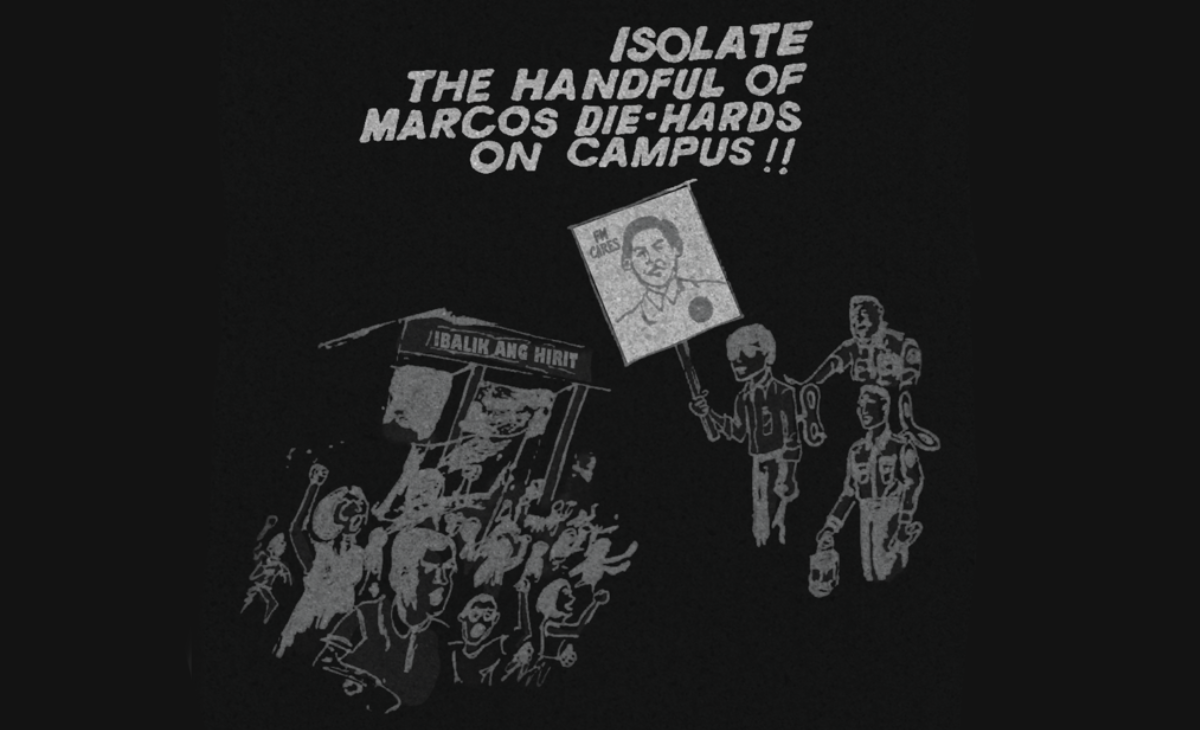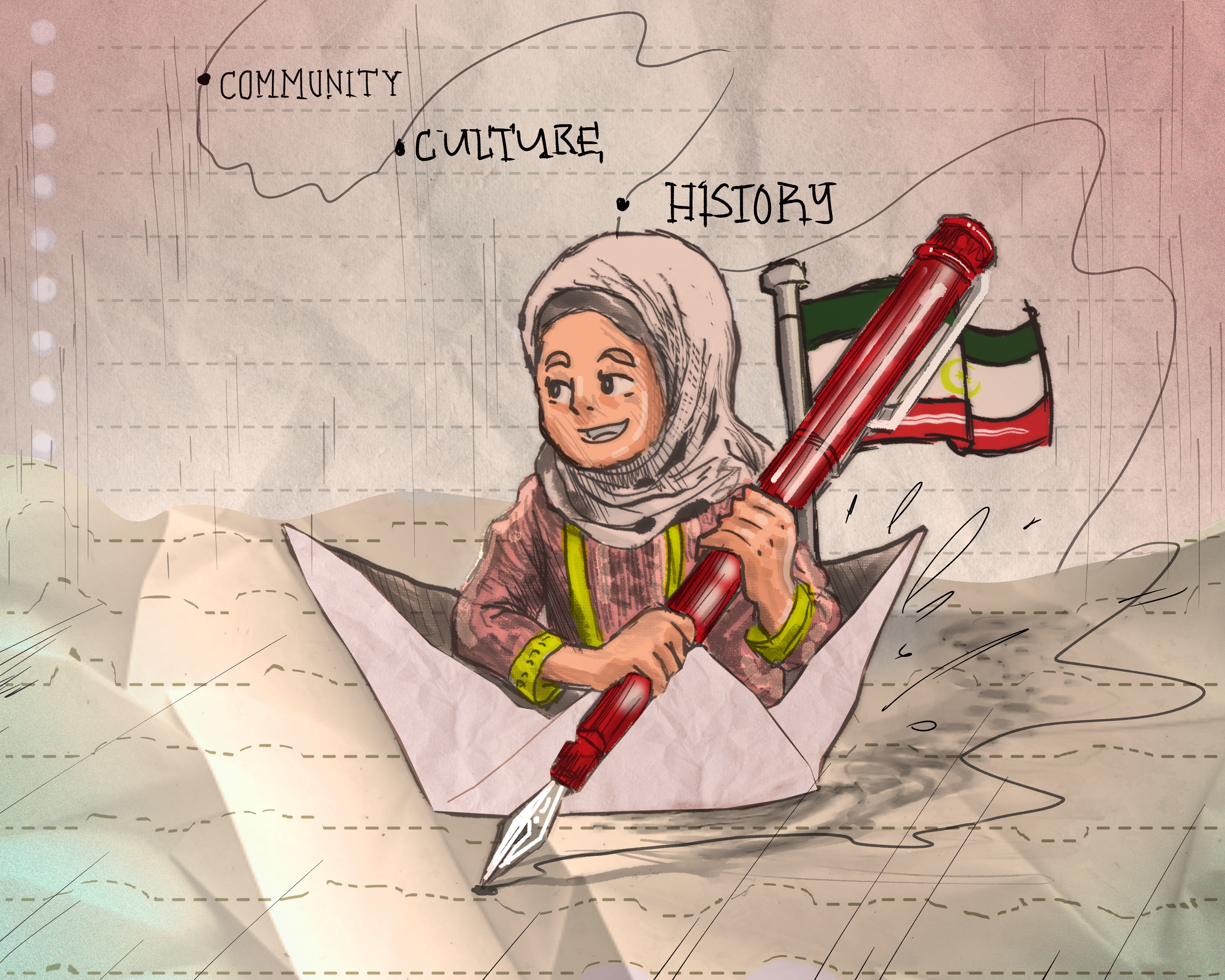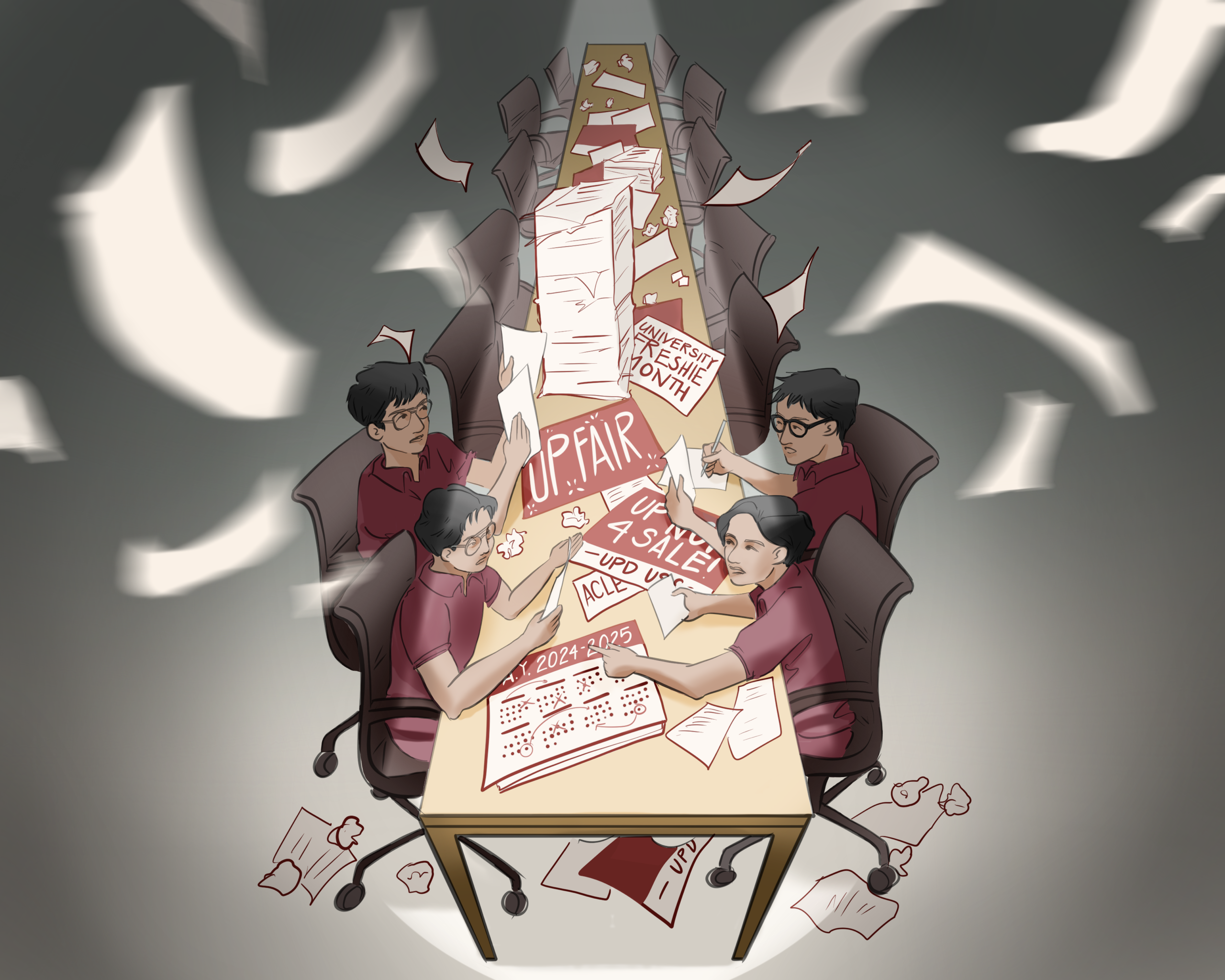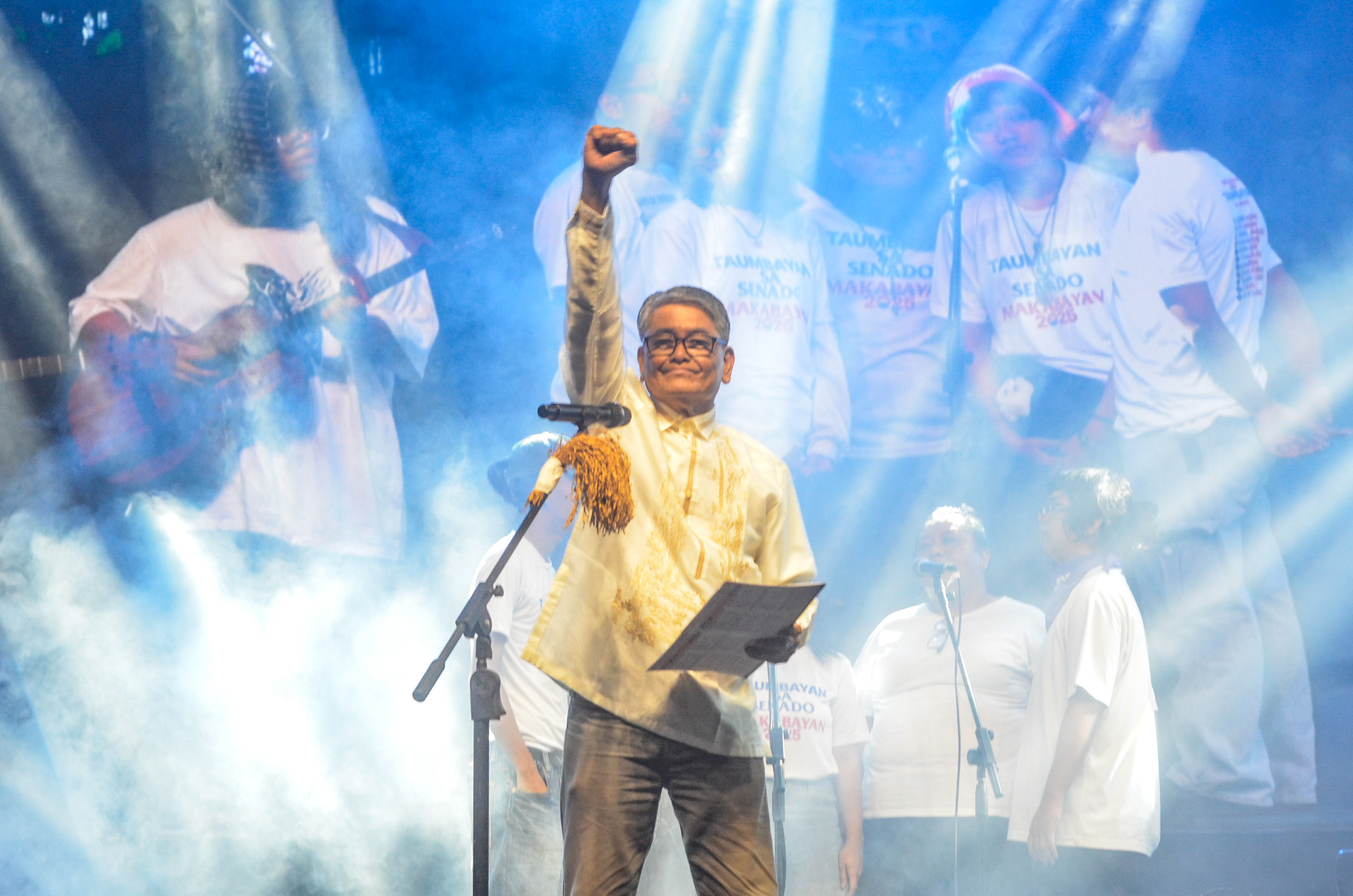By EDUARDO T. GONZALEZ & ZENAIDA B. MARIANO
The sun had not yet risen. The sea was indistinguishable from the sky, except that the sea was slightly erased as if a cloth had wrinkles in it. Gradually, as the sky whitened, a dark line lay on the horizon, dividing the sea from the sky and the grey cloth became barred with thick strokes moving, one after another, beneath the surface, following each other, pursuing each other, perpetually.
It was hard to tell how the citizenry felt just before Der Reichskanzler Marcos suspended the privilege of the writ of habeas corpus. August 23 was just as cheerless as any other day. Plaza Miranda II seemed not enough to break the spell of widespread sluggishness. To the professional cynic, it was a matter of letting things take their usual course—what’s just one more ghastly event, anyway, in the long series of past violent incidents?
Business was proceeding normally. The privileged classes went on with the routine of bourgeois mumbo-jumbos. Legislators—and con-con delegates as well—resumed the comedy of parliamentary fanfare after the little drama of shedding crocodile tears for the victims of the Plaza Miranda bombing. The urban petit-bourgeois casually exchanged verbal notes on the day’s bread-and-butter items, if not on crumpled dreams of “better living” in the stale confines of government bureaucracies. Speculators listlessly watched the stock market fluctuations while, in downtown areas, sidewalk hawkers haggled endlessly with early afternoon shoppers in an effort to obtain the best of compromises over prices. The lowly rest were either uneventfully asleep or leisurely preoccupied with their favorite anodynes: a bomba scenario on a theater’s screen, the day’s daily double, or a midday Nora Aunor radio special.
Until Herr Führer Marcos treated the nation to a prepacked bombshell: the intentionally belated proclamation of the writ suspension.
Then everything took a full 180-degree turn. Thirty-seven million minds with but a single thought—what’s it like now? Henceforth, the grim omen of liberal democracy behind prison walls loomed prominently in their minds.
Panic, perhaps, and confusion just after the announcement. There was no knowing when the ordeal would end. The weak-at-heart could only gasp uncomfortably at every arrest made, at every false accusation hurried, at every right trampled upon.
But the eerie prospects of prolonged insecurity could only open the doors to the dawning of the national consciousness. The president’s brusque interruption of “normalcy” highlighted a number of truths that even citizens of liberal or conservative persuasions could not evade. For a number of years only radical dissenters have marched, endured massacres, and seen their rights suppressed. Until some mad bomber throws a grenade at their feet, the “middle elements” of society would permanently prattle about “orderly reforms” and “return to sanity,” earnestly wishing, and thus deceiving themselves, that the crisis of society would simply go away. If there was no vigorous repression, no one would care a bit. Liberals were too much content with government rhetorics on quashing “peace and order” disturbance—carried on with eloquence on the “rule of law”—and dedicated to little else.
Now the situation is different. The dead weight of state fascism presses discomfitingly over most of the spectrum of social classes. Overnight the writ suspension has transformed mere possibilities of state repression into an actual methodical campaign of terror. The first casualties of the forces of reaction were significantly the Liberal Party oppositionists; their ordeal started several hours before the proclamation when their top leaders had been felled at the Plaza Miranda rally. “By their fruits ye shall know them,” says the Biblical injunction, and today the liberal sectors of the ruling classes are dimly aware that they won’t be spared from the hostile intentions of the Marcos puppet regime.
Popular sentimentality thus turns into a widespread gesture of defiance.Unite and organize! becomes the common, principled battle cry. The defense of civil liberties and democratic rights becomes the main impetus behind the popular protest. The air is lively, although passions are subdued. Ideological clashes between warring social groups are transformed to a non-antagonistic critical stance to give way to the broadest possible unity and political convergence of radicals and reformists, liberals and patriotic groups. The anti-fascist united front, once an abstract and diffused image, is gradually preparing itself for an engagement with the bitter truth of the oppressive status quo.
The sun rose higher. Blue waves, green waves swept a quick fan over the beach, circling the spike of sea-holly and leaving shallow pools of light here and there on the sand. A faint black rim was left behind them. The rocks which had been misty and soft hardened and were marked with red clefts.
The first to recover calmly from the shock of unholy Monday were, quite naturally, the militant radicals. Already accustomed to strenuous vigilance and having confronted the might of the state on many occasions, the national democratic movement was a far contrast to some of the ill-advised who, in the best traditions of social democracy, fled incontinently.
A day after the proclamation of the writ suspension, a rally was held under the aegis of the militant Movement for a Democratic Philippines (MDP). Five thousand angry young men and women fearlessly staged a protest march and wound up at Plaza Bustillos, where militant speakers took turns in denouncing the writ suspension as a calculated move to stifle dissent and whittle down all opposition to the “US-Marcos terrorists regime.”
It was not long, however, before more social aggrupations, representing widely differing ideological orientations, propped up to join the struggle against domestic oppression. The Citizens Movement for the Protection of Democratic Rights (CMPDR) assumed its humble beginnings by predicating its strategy on the principled unity of all freedom-loving sectors; Kilusan Laban sa Proklamasyon 889 (KLAP 889) chose a vertical alliance with the middle and upper reformist classes. Separately, they exerted steady efforts at gaining more adherents to a common anti-fascist struggle.
It was not long, too, before the need for broader bases for unity began to be experienced on a wider scale. Came Wednesday, August 25, and the first test of a radical-reformist entente cordiale met the approval of the student masses as the moderate UP Student Council and the radical Sandigang Makabansa mobilized the youth at Liwasang Bonifacio. Consequently, more parties tended to gravitate to the anti-fascist movement; the imperatives of a united stand became more discernible as “the faint black rim” of misunderstandings were gradually left behind. As the Marcos regime gave easy and instructive lessons in repression, more oppositionists forfeited their indifference to the struggle and abandoned their misty and soft stance in favor of a bolder and more extensive participation in the struggle against the chief marionette’s unobstructed and murderous domination.
The sun rose. Bars of yellow and green fell on the shore, gliding the ribs of the eaten-out boat and making the sea-holly and its mailed leaves gleam blue as steel. Light almost pierced the thin swift waves as they raced fan-shaped over the beach.
In the weeks that followed the proclamation, popular indignation was unlocked from time to time in mass demonstrations and protests. In the course of this campaign, all groups, although still acting in uncoordinated moves, successfully “glided the ribs of the eaten-out” ship-of-state. In the process, all the images of sustained militancy continued to impress many sympathetic citizens. The forms were as varied as the reasons invoked for protesting.
August 25. At the Philippine Science High School, the Supreme Student Council declared a general boycott of classes and called upon all progressive sectors of society to a nationwide protest against the pattern of suppression being presently woven by the Marcos regime.
On the 26th, the Malayang Kapulungan ng mga Makabayang Samahan (MAKAMASA) marched around the Quezon City area to denounce the beginning of the systematic crackdown on all opposition.
In Cebu and Iloilo, the National Union of Students (NUSP) joined the nationwide boycott of classes. On the same day, students, professors and workers of the Philippine College of Commerce staged a demonstration in front of Malacañan, asking the president to restore the writ protections and free the political prisoners detained in Camp Crame.
Still on this Thursday, the KASAPI staged a “March for Human Rights” together with its fraternal organizations, from the Quezon City Welcome Rotonda to the Liwasang Bonifacio. The moderates said that the suspension of the writ was an “overkill tactic.”
August 28. Despite the inclement weather over Manila, the MDP held an indignation rally and an overnight vigil at Plaza Miranda. Attended by thousands of workers, students, and peasants, the protesters heard well-known national figures speak of the carnage at the LP rally as a direct blow to the freedom of dissent. It was exactly one week after the massacre and the killers are still at large.
Came September 1, a rally was held at Liwasang Bonifacio, spearheaded by the CMPDR. Simultaneously, hundreds of student activists picketed the hearings on the writ petitions at the Supreme Court.
Both the radicals and the reformists held separate rallies on the 3rd: 8,000 people attended the Plaza Miranda assembly sponsored by the Student Alliance for National Democracy while, in front of Congress, 5,000 KLAP 889 partisans staged their own demonstration.
Tuesday, September 7. More than 6,000 UP students, faculty members, and non-academic workers, plus progressive instructors from PSHS, courageously marched to Malacañan to expose and oppose the fascist maneuvers of the US-Marcos regime.
In the span of two weeks, the protests yielded a rich harvest of slogans: Sigaw ng Bayan, Himagsikan! Digmaang Bayan, Sagot sa Martial Law! Palayain ang mga Bilanggong Pulitikal! Red flags fluttered while many colorful “peryodikit” adorned walls and street aisles. All this expressed the carnivalesque dimensions of protests, its clan, its peculiar urge toward a “festival of the oppressed.”
The wind rose. The waves drummed on the shore, like turbaned warriors, like turbaned men with poisoned assegais who, whirling their arms on high, advanced upon the feeding flocks…
In spite of the parallel path being taken by reformists and radicals in the protest movement in the cities, its absent center was conspicuous. Both camps showed notable political gains, but the state might yet confiscate the mass support they commanded in one decisive blow if they did not unite under the umbrella of a buffer alliance. Necessity impelled them to adjust the bounds of ideological divisions, and seek common shelter under the newly born Movement of Concerned Citizens for Civil Liberties.
Chaired by Sen. Jose W. Diokno, the MCCCL proved to be the explosive rouser of thousands of youths, civic leaders, progressive politicians, the clergy, labor groups, peasant associations, professionals, civil libertarians, national minority groups, and mass media practitioners. The membership, which cuts across the entire gamut of society, gave its nod to the three People’s Demands, namely: (1) immediate restoration of the privilege of the writ of habeas corpus; (2) immediate release of all political prisoners detained during the writ suspension; and (3) opposition to the imposition of Martial Law.
The national democratic movement, affirming its revolutionary commitment to national unity through struggle, actively participated in the alliance. The radicals’ move was not, as a doubting Thomas might honestly suspect, a surrender to compromise: The new grouping upheld the independence and initiative of each affiliate while each affiliate agreed to mutual concessions for the sake of long-term cooperation.
On Monday, September 13, 50,000 “concerned citizens” militantly marched to present the People’s Demands before the bar of public opinion. The feuds that had divided them ideologically took a temporary backseat in the unity of actual struggle; it was their common struggle, not their differing doctrines, that counted. By their concrete show of unity, they laid the formal foundations for the anti-fascist solidarity of all patriotic sectors and dealt a significant blow to the enemy.
The sun, risen, no longer couched on a green mattress darting a fitful glance though watery jewels, bared its face and looked straight over the waves. They fell with a regular thud. They fell with the concussion of horses’ hooves on the turf. Their spray rose like the tossing of lances and assegais over the riders’ heads. They swept the beach with steel blue and diamond-tipped water. They drew in and out with the energy, the muscularity, in an engine which sweeps its force out and in again.
The political balance sheet is today clearly in favor of the broad unity of widely varying sectors for the common struggle against fascism. The chances are bright that the present movement can be consolidated and expanded into a revolutionary anti-imperialist front—a resilient shield against the violence of American imperialism and its domestic minions. The people can only rejoice. The turn of events may yet increasingly displace the center of debate and action away from the mire of bourgeois politics, toward the important question of overthrowing oppressive state structures.
What is happening today is only a small beginning. But, to paraphrase Lenin, every little beginning is a great beginning, for after it—if not today, then tomorrow, and if not tomorrow, then the day after—will follow big continuations. ●
*Apologies to Virginia Woolf. All paragraphs in boldface were taken from Woolf’s The Waves. The article was first published in print in the Collegian’s September 24, 1971 issue, with the headline “WAVES OF THE PRESENT: One after another waves of protest rise and spread their rebellious message across the land.”







